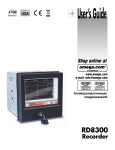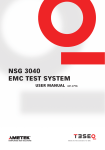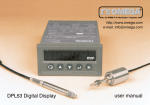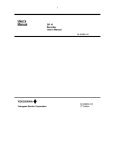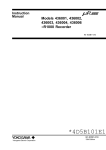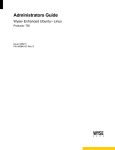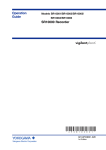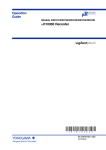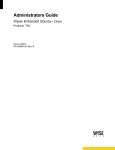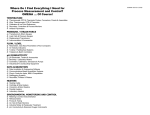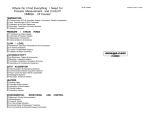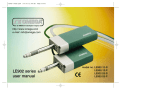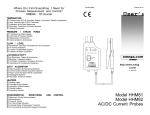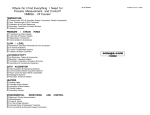Download RD260 - OMEGA Engineering
Transcript
User’s Guide http://www.omega.com e-mail: [email protected] RD260 RECORDER Technical Manual OMEGAne t ® On-Line Service http://www .omega.com Internet e-mail [email protected] Servicing North America: USA: ISO 9001 Certified Canada: One Omega Drive, Box 4047 Stamford, CT 06907-0047 Tel: (203) 359-1660 e-mail: [email protected] 976 Bergar Laval (Quebec) H7L 5A1 Tel: (514) 856-6928 e-mail: [email protected] FAX: (203) 359-7700 FAX: (514) 856-6886 For immediate technical or application assistance: USA and Canada: Sales Service: 1-800-826-6342 / 1-800-TC-OMEGASM Customer Service: 1-800-622-2378 / 1-800-622-BESTSM Engineering Service: 1-800-872-9436 / 1-800-USA-WHENSM TELEX: 996404 EASYLINK: 62968934 CABLE: OMEGA Mexico and Latin America: Tel: (001) 800-826-6342 En Español: (001) 203-359-7803 FAX: (001) 203-359-7807 e-mail: [email protected] Servicing Europe: Benelux: Postbus 8034, 1180 LAAmstelveen, The Netherlands Tel: (31) 20 6418405 FAX: (31) 20 6434643 Toll Free in Benelux: 0800 0993344 e-mail: [email protected] Czech Republic: ul. Rude armady 1868, 733 01 Karvina-Hranice Tel: 420 (69) 6311899 FAX: 420 (69) 6311114 Toll Free: 0800-1-66342 e-mail: [email protected] France: 9, rue Denis Papin, 78190 Trappes Tel: (33) 130-621-400 Toll Free in France: 0800-4-06342 e-mail: [email protected] FAX: (33) 130-699-120 Germany/Austria: Daimlerstrasse 26, D-75392 Deckenpfronn, Germany Tel: 49 (07056) 3017 Toll Free in Germany: 0130 11 21 66 e-mail: [email protected] United Kingdom: ISO 9002 Certified FAX: 49 (07056) 8540 One Omega Drive, River Bend Technology Centre Northbank, Irlam, Manchester M44 5EX, United Kingdom Tel: +44 (0) 161 777-6611 FAX: +44 (0) 161 777-6622 Toll Free in United Kingdom: 0800-488-488 e-mail: [email protected] It is the policy of OMEGA to comply with all worldwide safety and EMC/EMI regulations that apply. OMEGA is constantly pursuing certification of its products to the European New Approach Directives. OMEGA will add the CE mark to every appropriate device upon certification. The information contained in this document is believed to be correct, but OMEGA Engineering, Inc. accepts no liability for any errors it contains, and reserves the right to alter specifications without notice. WARNING: These products are not designed for use in, and should not be used for, patient-connected applications. Notes • The contents of this manual are subject to change without prior notice as a result of improvements in the instrument’s performance and functions. Display contents illustrated in this manual may differ slightly from what actually appears on your screen. • Every effort has been made in the preparation of this manual to ensure the accuracy of its contents. However, should you have any questions or find any errors, please contact OMEGA Engineering. All Rights Reserved, Copyright © 1988 i SAFETY PRECAUTIONS This recorder is developed to satisfy and to be used under the following conditions: • It is a component type instrument to be installed on an instrumentation panel or rack. • It complies with the IEC class II safety standard. • It complies with the EN61010-1 safety standard. • It complies with the CSA1010-1 safety standard. • It is based on EN55011 (EMI) Group 1, Class A (for commercial and industrial use). • It complies with the EN50082-2 (EMS) safety standard. General definitions of safety symbols used on the recorder and in this manual: Make sure to comply with the following safety precautions. Not complying might result in injury, death of personnel, or cause damage to the instrument. We assume no liability for customer’s failure to comply with these requirements. Where this mark is found on the recorder there is danger of injury or death. Please check the manual carefully In-position of bistable push control Power ON Alternating current Power OFF Functional earth terminal (This terminal should not be used as a “Protective earth terminal”.) Equipment protected throughout by double insulation or reinforced insulation (Class II) Out-position of bistable push control WARNING Power Supply Ensure the source voltage matches the voltage of the power supply before turning ON the power. Grounding Make sure to ground the recorder before turning on the power. Necessity of Grounding Grounding is necessary to prevent noise interference. Do not Operate in an Explosive Atmosphere Do not operate the recorder in the presence of flammable liquids or vapors. Operation of any electrical instrument in such an environment constitutes a safety hazard. Keep Away from Live Circuits Inside this recorder there are areas of high voltage; therefore, never touch the interior when the power supply is connected. The recorder has replacable parts and subassemblies; however, the replacement must be carried out only by our service personnel. External Connection Before connecting to measurement and control unit, connect the grounding wire. ii Using the Technical Manual This manual contains information about the instrument’s functions and operating procedures as well as precautions that should be observed during use. To ensure proper use of the instrument, please read this manual thoroughly before operating it. Keep the manual in a safe place for quick reference whenever a question arises. Two manuals are provided with the instrument, including this Technical Manual. Manual Name Description User’s Manual Basic information for recorder operators. Technical Manual Detailed technical manual for recorder engineers, including mounting, wiring and setting information. Read this manual first. Structure of this Manual This Manual is intended for technicians in charge with installing, and wiring, and with the making of the recorder settings. The additional User’s Manual is intended for simple daily operation of the recorder. Chapter Title Content 1 Preparation Read this before unpacking the recorder. List of accesories and explanation of the basic functions and display. Also describes the mounting and wiring required before use. 2 Regular Settings Explains the Regular Setting mode mode, in which dailyused settings such as input range, recording span, alarm setpoints, and chart feed speed are made. 3 Basic (SETUP) Settings Explains the Basic (SETUP) Setting Mode, for the adjustment of a whole range of detailed settings such as the pen’s position, dot printing postion and color, the noise input filter, a remote trigger settings. 4 Calibration and Adjustment Explains how to calibrate the recorder and how to adjust pen, dot and ribbon posiions. 5 Periodic Inspection About periodic maintenance and cleaning of the recorder. 6 Troubleshooting Explains the meaning of error messages on recorder display and a troubleshooting check list. Index iii Using the Technical Manual Conventions Used in this Manual Displayed characters Bold alphanumeric characters enclosed with [ ] refer to characters or setting values that are displayed on the screen. Symbols The following symbol marks are used to attract the operator’s attention. Affixed to the instrument. Indicates danger to personnel or instrument and the operator must refer to the User’s Manual. ThinUser’s Manual to indicate the reference. WARNING Describes precautions that should be observed to prevent injury or death to the user. CAUTION Describes precautions that should be observed to prevent minor or moderate injury, or damage to the instrument. Note iv Provides important information for the proper operation of the instrument. Contents 1 SAFETY PRECAUTIONS ................................................................................................................ ii Using the Technical Manual ......................................................................................................... iii 2 Chapter 1 Preparation ........................................................................................................................... 1-1 1.1 1.2 Checking Accessories and Appearance ............................................................................... 1-1 Removing Packings .............................................................................................................. 1-2 1.3 1.4 Checking Model Codes ........................................................................................................ 1-3 Front/Rear Panels: Functions and Display ........................................................................... 1-4 1.5 1.6 Handling Precautions ........................................................................................................... 1-6 Mounting ............................................................................................................................... 1-7 1.7 Wiring ................................................................................................................................. 1-10 Chapter 2 Regular Settings .................................................................................................................. 2-1 2.1 2.2 Introduction to Regular Settings ........................................................................................... 2-1 Setting Input Range and Recording Span ............................................................................ 2-3 2.3 2.4 Setting Alarm Functions ........................................................................................................ 2-8 Adjusting the Chart Speed .................................................................................................. 2-10 2.5 2.6 Setting the Dot Printing Interval (Dot Model) ...................................................................... 2-11 Setting the Key-Lock .......................................................................................................... 2-12 Chapter 3 Basic (SETUP) Settings ...................................................................................................... 3-1 3.1 Introduction to Basic (SETUP) Settings ................................................................................ 3-1 3.2 3.3 3.4 Setting Relay for post-Alarm (de-)Energizing ....................................................................... 3-4 Setting Alarm Hysteresis ...................................................................................................... 3-5 Selecting A/D Integration Time (Pen Model) ......................................................................... 3-6 3.5 3.6 TC Burnout Registration Method .......................................................................................... 3-7 Setting the Noise Input Filter (Pen Model) ............................................................................ 3-8 3.7 3.8 Setting Moving Average Calculation (Dot Model) ................................................................. 3-9 Offset Values ...................................................................................................................... 3-10 3.9 Assigning Channel Printing Colors (Dot Model) ................................................................. 3-12 3.10 Selecting Celsius or Fahrenheit .......................................................................................... 3-13 3.11 Remote Trigger for Recording or Chart Speed ................................................................... 3-14 3.12 Protecting Settings ............................................................................................................. 3-15 3.13 Initializing Settings .............................................................................................................. 3-16 Chapter 4 Calibration and Adjustment ................................................................................................ 4-1 4.1 4.2 Calibration ............................................................................................................................ 4-1 Re-adjusting the Pen-Position (Pen Model) ........................................................................ 4-3 4.3 Re-adjusting the Dot-Position (Dot Model) .......................................................................... 4-5 Chapter 5 Periodic Inspection ............................................................................................................. 5-1 5.1 Periodic Inspection ............................................................................................................... 5-1 Chapter 6 Troubleshooting .................................................................................................................. 6-1 6.1 6.2 Index Error Messages .................................................................................................................... 6-1 Troubleshooting .................................................................................................................... 6-2 ................................................................................................................................ Index-1 v 3 4 5 6 Index Chapter 1 Preparation 1.1 Checking Accessories and Appearance 1 This recorder has been thoroughly inspected before shipment; however, when you receive the recorder, check that all accessories are present and in the correct quantities. Also check the external appearance of the recorder to ascertain that no damage has occurred. Checking Accessories and Appearance The recorder should be accompanied by the accessories indicated below. Check that all are present in the correct quantities. Also check the external appearance of the recorder to ascertain that no damage has occurred. Accessories No. Name Quantity 1 Disposable felt pen 1-pen model 2-pen model 3-pen model 1 2 3 Only for pen models Red Red, green Red, green, blue 2 Ribbon cassette 1 Only for dot model 3 Mounting brackets 2 4 Z-folded chart paper 1 Approx. 16 meter 5 Instruction manuals 2 1 User’s Manual & 1 Technical Manual 1 3 Remarks 2 4 5 Spare Parts Name Part No. Quantity* Remarks Disposable felt pen (red) RD260-01 Disposable felt pen (green RD260-02 Disposable felt pen (blue) RD260-03 3 Only for pen models 3 Only for pen models 3 Only for pen models Ribon cassette RD260-RC 1 Only for dot model Mounting brackets B9962CG 2 Z-folded chart paper RD260ZFP 10 Approx. 16 meter *The amount of items per ordered Part No. 1-1 Preparation Checking and Unpacking 1.2 Removing Packings The internal assembly is secured in position by packings to safeguard against damages during transit. Before you unpack the recorder please read the following. Opening the front door Open the front door by pushing and then puling the clip on the right, as shown below, and open the display by pulling its left end after removing the adhesive tape. CAUTION Do not push the display bar further after you feel a click. • Please take care not to apply any undue pressure in an upward or downward direction to the display. This might cause a strain on the hinges. 100° • When you open the display further than about 100 degrees you will feel a clicking resistance which marks the largest possible opening for the display. Do not try to open the display further than upto that point as it may break. Removing Protective Lock Screw and Packings Pen model Dot model 5 Display CH 4 Status display RCD ALM DATA ESC RCD MENU FEED CH UP 2 Key panel 3 Chart cassette Packing material 1-2 Display 1 Power switch 1.3 Checking Model Codes 1 order. The nameplate is visible after you removed the chart cassette and is as shown in the figure below. When you contact Omega, inform the model code (MODEL) and the serial number (No.). MODEL SUFFIX NO. OMEGA Made in Japan Nameplate 1-3 Preparation Check the model codes on the nameplate to make sure they are as specified by your 1.4 Front/Rear Panels: Functions and Display Front Panel 5 Display CH 4 Status display RCD DATA ALM ESC RCD MENU FEED CH UP 2 Key panel 3 Chart cassette 1 Power switch 1. Power switch (push-button type) Pressing the switch turns the power ON and OFF. 2. Key panel (push-key type) The panel contains the follwing five keys: RCD RCD key Pressing the key starts or stops the recording. ESC DISP DISP key, ESC key DISP function: Cycles through the modes of display in the order of AUTO, MANUAL, and OFF. Also selects between the Regular Setting mode and Operation mode (see Section 2.1). If this key is pressed for three seconds, the recorder enters the Regular Setting Mode. ESC function: Exits from the menu in the middle of setting or selecting procedures. key Selects setting parameters (numerics or command codes). Selecting step is upward circulation. If the recorder is a pen model, pressing this key for three seconds in operation mode causes the recorder to enter the pen-replacement mode. FEED CH UP 1-4 FEED key, key FEED function: The chart is fed as long as this key is being pressed. key function: Changes the number of digits for setting numeric values. The digit moves from high to low. CH UP key, ENT key CH UP function: Selects a channel for which the display shows the screen in the MANUAL display mode. function: Makes a parameter entry or executes a function after selecting parameters (numerals or command codes). Pressing the key executes the settings. Front/Rear Panels: Functions and Display 3. Chart cassette 1 Contains a Z-fold chart (width: 100 mm, length: 16 m). ALM indicator:Will illuminate when an alarm occurs. 5. Seven-segment character display Used to display data, setting screen, etc. • Data display: Displays channel No., type of alarms, and measured data. • Setting screen: Displays various settings of the recorder. Characters on Display The display consists of seven segments, and therefore characters exist which are difficult to display. Characters are presented on the display as shown in the following table. Display Alphabet A B C D E F G H h I J K L l M N O P Q R S T U V W X Y Z Display Alphabet Rear Panel Below, the rear panel of the dot model reorder, for more details and the rear of the pen model recorder see Section 1.7, Wiring. Optional terminals Power terminal L N Input terminals 1-5 Preparation 4. Status Display RCD indicator: Illuminated when recording of measurement values is in progress. 1.5 Handling Precautions Safety precautions • Before you use this recorder make sure to read the Safety Precautions on page 2 of this manual. • Do not touch the interior of this recorder. For the replacement of parts, please contact OMEGA Engineering. • Turn the recorder power switch off as soon as any symptoms of malfunction such as unusual sound, smell, or smoke yield from the recorder. Also turn the main power switch off. If a malfunction occurs, contact OMEGA Engineering. General handling precautions • The recorder contains many plastic parts. To clean, use a soft, dry cloth. Do not use chemicals such as benzene or thinner, since these may cause discoloration or damage. • Do not bring any objects charged with static electricity near the signal terminals. This might cause malfunction. • Do not allow any volatile substances to the front or key panel. Do not allow rubber or vinyl to remain in contact with the recorder for long periods. • Whenever the recorder is not used, turn the power switch OFF. 1-6 1.6 Mounting 1 Preparation Before mounting the recorder make sure to read this chapter carefully. Installation Site Panel and rack mounting • The recorder is designed to be installed on an instrumentation panel or rack. Well ventilated location • Install the recorder in a well ventilated site to prevent internal overheating. Avoid mechanical vibration • To install the recorder in a location susceptible to mechanical vibration will adversely affect the mechanical parts and the quality of recording. Please choose an installation site with minimal mechanical vibration. Horizontal installation • The recorder must be installed horizontally from left to right. Backward or forward mounting may slant 0˚ to 30˚. Avoid direct sunshine or heater radiation. • The recorder will be adversely affected if the unit is exposed to direct sunlight or installed near a heater. Choose a location near room temperature (23˚C) with minimal temperature fluctuation. Keep out of soot, steam, moisture, dust, corrosive gases • The recorder will be damaged if exposed to soot, steam, moisture, dust, corrosive gases, etc., Avoid electro-magnetic fields • To use the recorder within strong electro-magnetic fields may cause malfunction. Please avoid installing near electro-magnetic objects. Mounting Methods 1 The recorder has three small square windows lined on the right, left, bottom and top of the recorder to apply mouting brackets. Remove the plastic inside frames of the square windows ,as shown in the below illustration, by flipping them out with a small screwdriver. Don’t let the frames fall inside. CAUTION • Take care not to damage the interior of the recorder when flipping the plastic frames out of the windows. Don’t insert the driver too far. 2 Insert the recorder into the panel-front face (continued on next page). 1-7 Mounting 3 Mount the recorder on a steel panel which thickness is at least 2 mm (and up to 26 mm). Fix the recorder to the panel using the mounting brackets as shown in below. Adequate screw tightening torque is approximately 3 to x kg-cm. A pair of mounting brackets can be applied to the recorder’s top and bottom, or to both side faces. CAUTION • A tightening torque exceeding the above-mentioned adequate values may cause deformation of the recorder case or brackets. Mounting bracket 1-8 Mounting External Dimensions 1 Panel Cutout and External Dimensions (including Mounting Brackets). Preparation Unit : mm (approx. inch) If not specified, the tolerance is ± 3%. When less than 10 mm, however, tolerance is ± 3 mm. (1.08) 27.5 151.5 (5.96) 175 (6.89) 2 to 26 (panel thickness) (min. space for mounting ) +0.2 (0.3) 136.5 0 (5.37) 11 144 (5.67) 151.5 (5.96) 7.5 144 (5.67) (dimension after mounting ) (0.43) Panel Cutout & Spacing Side-by-Side Mounting (horizontally) Single-Unit Mounting Side-by-Side Mounting (vertically, max. 3 units) +2 0 +2 137 (5.39) 137 0 (5.39) +2 137 0 (5.39) 175 MIN (6.89) +2 137 0 (5.39) L L Units +2 0 L +2 0 (mm) 2 282 3 426 4 5 570 714 6 858 7 1002 8 1146 9 1290 10 n +2 0 175 MIN (6.89) 1434 (144xn)-6 Note • A pair of mounting brackets should be used on the top and bottom, or on both sides of the recorder. 1-9 1.7 Wiring Wiring should be done only after you have read this section. The section consists of the following subsections: page: 1-10 Rear Panel Terminal Arrangement 1-11 Power Supply Wiring 1-12 Input Signal Wiring 1-14 Alarm Output Wiring 1-15 Remote Control Wiring WARNING • Make sure to fasten the wiring at the rear wall of the mounting panel and employ some kind of strain relief between the rear wall and the recorder to prevent an electric shock. Rear Panel Terminal Arrangement Pen Model Optional terminals Terminal screws: ISO M4, nominal length 6 mm The terminal blocks can be detached from the case by removing these screws for easy wiring. Tighten the terminal screws properly to ensure proper contact. Power terminal L N Input terminals Dot-Printing Model Optional terminals Terminal screws: ISO M4, nominal length 6 mm The terminal blocks can be detached from the case by removing these screws for easy wiring. Tighten the terminal screws properly to ensure proper contact. Power terminal L N Input terminals 1-10 Wiring Power Supply Wiring 1 • To prevent an electric shock, ensure the main power supply is turned off before wiring. • To prevent fire, use 600 V PVC insulated wire (AWG18) for power and ground wiring (cross sectional area of 0.83 mm2 or thicker, anti-galvanic corrosion finish, insulation thickness should be more than 0.8 mm, insulation resistance ahould be more than 50 M Km at 20˚C, approved EN60 320 (VDE0625) ), or equivalent cables. • Connect the protective grounding wire to the earth through grounding resistance less than 100 before turning on the power . • Use crimp on lugs (for 4 mm screws) with insulation sleeves. • To prevent an electric shock, cover the power terminals certainly with the transparent cover. • Make sure to apply a power switch with the following characteristic: rated power current > 1A rated rush current > 60A fuse(s) of 2 to 15A Wiring method 1 The rated power supply voltage for the recorder is 100 to 240 V AC. 2 Turn the recorder’s power switch OFF. 3 Open the transparent cover of the power terminal after releasing the cover screw. 4 Connect the power supply wires and the protective ground wire to the terminal. To prevent an emission of electromagnetic disturbances, separate the input wires from the other wires at least 0.1 m. Over 0.5 m is recommended. 5 Cover the terminals with the transparent cover, and secure the screw. Power Supply Wiring L N Functional earthing cord Power supply wires Note • Do not apply a power supply in the range from 132 V to 180 V AC. Doing so might affect the measuring accuracy. • To prevent emission of electromagnetic disturbances, separate the power supply wires from the other wires at least 0.1 m. Over 0.5 m is recommended. 1-11 Preparation WARNING Wiring Input Signal Wiring WARNING To prevent an electric shock, ensure the main power switch is turned off when wiring. CAUTION Do not apply inputs exceeding the rated range as follows to prevent the recorder from damage: • Maximum input voltage ±10 V DC for TC, and for the voltage range of 2 V DC or less ±30 V DC for the voltage range of 6 to 20 V DC • Maximum common mode voltage 250 V AC rms (50/60 Hz) • This instrument complies with Installation Category II. 1 Turn off the recorder power switch. 2 Remove the transparent cover for the input signal terminals. 3 Connect the input signal wires to the terminals. To prevent an emission of electromagnetic disturbances, separate the input wires from the other wires at least 0.1 m. Over 0.5 m is recommended. 4 Attach the cover on the terminals, and secure the screws. It is recommended to use the crimp-on lugs (for 4 mm screws) with insulation sleeves for lead wire ends, but they are not required for thermocouples (TC) . Crimp-On Lugs Suggestions to minimize noise pickup: • Separate the measuring-signal wires from power lines and grounding lines. • It is desirable that the measuring object is not a noise source; if not, insulate it from the measuring signal wires and ground the object. • It is recommended to use shielded wires to minimize noise pickup from an electrostatic induction source. The shields are connected to the recorder’s grounding terminal, if necessary. In that case, avoid two-point grounding. • To minimize the noize from an electrostatic induction noise, twist the measuring wires (a pair of wires) in short and equal intervals. • The grounding line must have low resistance. 1-12 Wiring For TC (thermocouple) inputs the ambient temperature around the recorder’s terminal board should be kept as stable as possible. because it has a large radiation rate. • Keep the ambient temperature as stable as possible; start/stop of a nearby fan can considerably affect the temperature. If input signal wires are connected to two or more receivers with parallel connection, measured values sometimes affect each other. The following notes should be observed for parallel connection: • Ground each receiver at the same point. • Do not turn on/off the power of a receiver while other receivers are in measuring operation. • A resistance temperature sensor (RTD) cannot be used essentially in parallel connection. Terminal Board (Pen Model) Terminal Board (Dot Model) RTD DC Voltage, TC DC Voltage, TC 1 ch 2 ch 3 ch 1 ch 2 ch 3 ch + _ A + B _ 4ch 5 ch 6 ch b Input terminal Input terminals Wiring for Input Terminals DC voltage Inputs TC input + - Extension wires + + DC voltage Input - - RTD input (for dot model only) A B b B A b DC current input + - + DC current input - Shunt resistor Wire resistance per one line: 10 Ω or less Three wires should have the same resistamce values Example: The shunt resistor rating is 250 Ω ± 0.1% for the current input of 4 to 20 mA. 1-13 Preparation • Cover the input terminals with the transparent cover. • Do not use a large-diameter wire (cross sectional area of more than 0.5 mm2) 1 Wiring Alarm Output Wiring (optional) WARNING To prevent an electric shock, ensure the power switch is turned off before wiring. Depending on the type (the number of outputs) of alarm relay options, the terminal arrangement changes as shown in the following: Alarm Output Terminal Arrangements ALARM 1 NO 2 NO C C NC NC -A2 Option (2 outputs) ALARM 1 NO 2 NO 3 NO 4 NO C C C C NC NC NC NC -A4 Option (4 outputs) Contact characteristics Output type Output capacity : Relay transfer contacts : 250 V AC (50/60 Hz), 3 A. 250 V DC, 0.1 A (resistive load) Dielectric strength : 1500 V AC (50/60 Hz) for one minute between output terminals and grounding terminals Wiring method 1 Turn the power switch off. 2 Remove the transparent cover of the optional terminals. 3 Connect the alarm output wires to the optional terminals. To prevent an emission of electromagnetic disturbances, separate the alarm output wires from the power supply and input wires at least 0.1 m. Over 0.5 m is recommended. 4 Cover the terminals with the transparent cover and secure the screws. 1-14 Wiring Remote Control Wiring (optional) 1 Preparation WARNING To prevent an electric shock, ensure the power switch is turned off before wiring. Remote Control Terminals Arrangements: REMOTE 1 2 C Input characteristics Input signal: Dry contact, open-collector (TTL or transistor) signal. Control functions and signal types: (1) Recording start/stop (2) Chart speed change Signal characteristics: ON voltage Leakage current in OFF state Signal duration Input types: level level 0.5 V or less (30 mA DC) 0.25 mA or less 250 ms or more Photocoupler isolation (one line common). Internal isolated power source (5 V ±5%). Dielectric strength: 500 V DC for one minute between input terminals and grounding terminal. Wiring method 1 Turn the power switch off to revent an electric shock. 2 Remove the transparent cover of the optional terminals. 3 Connect the wires for remote control to the optional terminals. The C is the terminal common to other 1 to 2. To prevent an emission of electromagnetic disturbances, separate the input wires from the other wires at least 0.1 m. Over 0.5 m is recommended. 4 Cover the terminals with the transparent cover and secure the screws. Note • Use shielded cables for remote control signals to prevent noise pickup. The shield should be grounded at the recorder’s terminal. 1-15 Chapter 2 Regular Settings 2.1 Introduction to Regular Settings Three Recorder Modes Note While in the Basic (SETUP) mode, measurement, recording, and alarm detection are not carried out. Using the settings protection function, you can protect your settings by defining a password when you enter the Regular or Basic (SETUP) mode. Turning the Recorder Modes ON Power ON while pressing the CH UP (ENT) key. Power ON Operation mode Regular Setting mode Mode changes to the other by pressing the DISP key for three seconds. Basic SET UP mode Leaving the Basic SET UP mode is done by the SET UP END procedure. Turning the Recorder Modes OFF Power ON while pressing the CH UP (ENT) key. Power ON QUIT SET UP Password Regular Setting mode Operation mode Basic SET UP mode *1 *1 Password *1 Mode changes to the other by pressing the DISP key for three seconds. Leaving the Basic SET UP mode is done by SET UP END procedure. 2-1 2 Regular Settings Operation Mode This is the mode for daily operation, described in the ; when the power turns on, the recorder automatically enters this mode. Select from the following functions by pressing the appropriate keys on the key panel. key Replacement of pens (pen model only). See User’s Manual Section 2.5. RCD key Starting/stopping the recording. FEED key Feeding the chart. See User’s Manual Section 2.1. DISP key Selection from the modes on display. See User’s Manual Section 1.1. Regular Setting Mode In the Regular Setting mode, described in this Chapter, daily-used settings such as input range, recording span, alarm setpoints, and chart feed speed are made. Pressing the DISP key three seconds in the operation mode changes the mode to the Regular Setting mode. Basic (SETUP) Setting Mode (see Section 3) In the Basic (SETUP) Setting Mode, you can adjust a whole range of detailed settings such as the pen’s position, dot printing postion and color, the noise input filter, and remote trigger settings. Enter this mode by turning the power ON while pressing the CH UP(ENT) key. Introduction to Regular Settings Flow Chart Regular Setting Mode 2.2 Voltage input setting and span Span (L) Span (R) Range 2.2 TC input setting and span setting Span (L) Span (R) Type Span (L) Span (R) Span (L) Span (R) 2.2 RTD input setting and span setting Type Range 2.6 Scaling setting Scale (L) Scale (R) 2.2 No measurement, recording, or display of unused channel 3.8 Offsets (when offset settings protection function is ON only) Offset Channel No. 2.3 Alarm functions Channel No. Alarm level Alarm on/off Type of alarm Alarm point Contact output Relay No. 2.4 Chart feed speed First/second speed Chart feed speed 2.5 Dot-printing interval in analog records (dot model) 2.6 Key lock : Numeric value input 2-2 2.2 Setting Input Range and Recording Span Setting Input Range and Recording Span One of the following parameters can be set for every channel: SKIP Prevents the specified channel from being measured, recorded and displayed . 2 VOLT Measures and records DC-voltage. TC Measures and records temperatures using Thermocouple. Regular Settings RTD SCL Measures and records temperatures using Resistance Temperature Detector . Performs scaling on voltage measurements. Scaling results in appending a different scale to the measured values. Restrictions apply to the measurable types of input depending on the type of recorder used. Check your recorder type as indicated on the nameplate (see Section 1.3 for details on the nameplate), and then refer to the following table: Model Code RD260 Measurable Type of Input Voltage (VOLT), thermocouple (TC), SCL RD266-RTD Resistance temperature detector (RTD, dot–models only) SKIP Setting Unused channels can be skipped, which means that these channels will not be measured, recorded or displayed. Setting Procedures Press the DISP key for three seconds to enter the Regular Setting mode. ESC DISP 3 sec Select the [Range] display by using the key. Then press the ENT key. CH UP .. . Use the key to select the desired channel. Press the ENT key. .. . Use the CH UP key to select [Skip]. Press the ENT key. CH UP [Range] is displayed and the setting is completed. Press the ENT key to set another channel; or press the ESC CH UP or DISP 3 sec DISP key for three seconds to return to the Operation mode. 2-3 Setting Input Range and Recording Span Voltage Measurement Setting (VOLT Setting) If the measured signal is a DC-voltage, the range can be set as follows: Setting Procedures ESC DISP Press the DISP key for three seconds to enter the Regular 3 sec Setting mode. Select the [Range] display by using the Then press the ENT key. CH UP .. . Use the key. key to select the desired channel. Press the ENT key. CH UP Use the key to select [Volt]. Press the ENT key. CH UP .. . Select the desired range using the ENT key. Display CH UP keys and press the Range –20.00 to 20.00mV –60.00 to 60.00mV –200.0 to 200.0mV –2.000 to 2.000V –6.000 to 6.000V –20.00 to 20.00V Select the minimum value of the recording span (SPAN L) using the and keys. Then press the ENT key. FEED CH UP The display which appears will allow you to enter the maximum value of the recording span (SPAN R). Select it FEED the same way as for the minimum value and press the ENT key. CH UP The recording span cannot be beyond the input range, nor can SPAN L be equal to SPAN R. [Range] is displayed and the setting is completed. ESC CH UP 2-4 or DISP 3 sec Press the ENT key to set another channel; or press the DISP key for three seconds to return to the Operation mode. Setting Input Range and Recording Span Setting Thermocouple and Resistance Temperature Detector (dot model only) In the case that the measured signal is a TC (Thermocouple), or -for dot models onlyRTD (Resistance Temperature Detector), the range can be set the same way as if it were a DC-voltage. 2 Setting Procedures Press the DISP key for three seconds to enter the Regular 3 sec Setting mode. Select the [Range] display by using the Then press the ENT key. CH UP .. . Use the key. key to select the desired channel. Press the ENT key. CH UP .. . Use the key to select [TC], or [RTD]. Press the ENT key. CH UP .. . Select the desired type (R, S, B, K, E, J, T, N, W, L, U in case of TC, or PT, JPT in case of RTD) using the key and press the ENT key. TC Type Description and RTD Type Description CH UP TC Type Description Range ( Type R ) 0.0 to 1760.0°C 32 to 3200°F ( Type S ) 0.0 to 1760.0°C 32 to 3200°F ( Type B ) 0.0 to 1820.0°C 32 to 3308°F ( Type K ) –200.0 to 1370.0°C –328 to 2498.0°F ( Type E ) –200.0 to 800.0°C –328.0 to 1472.0°F ( Type J ) –200.0 to 1100.0°C –328.0 to 2012.0°F ( Type T ) –200.0 to 400.0°C –328.0 to 752.0°F ( Type N ) 0.0 to 1300.0°C 32 to 2372°F ( Type W ) 0.0 to 2315.0°C 32 to 4199°F ( Fe-CuNi ) –200.0 to 900.0°C –328.0 to 1652.0°F ( Cu-CuNi ) –200.0 to 400.0°C –328.0 to 752.0°F RTD Type Description Range (pt 100 Ω) –200.0 to 600.0°C –328.0 to 1112.0°F (jpt 100 Ω) –200.0 to 550.0°C –328.0 to 1022.0°F Select the desired minimum value (SPAN L) and maximum FEED value of the recording span (SPAN R) in the same way as described under ‘VOLT setting’. CH UP The recording span cannot be beyond the input range, nor can SPAN L be equal to SPAN R. [Range] is displayed and the setting is completed. ESC CH UP or DISP 3 sec Press the ENT key to set another channel; or press the DISP key for three seconds to return to the Operation mode. 2-5 Regular Settings ESC DISP Setting Input Range and Recording Span Scale Setting (SCL Setting) To assign a different scale to the measured data, the range can be set as described below. Note that the measured data which can get a different scale must be of the voltage (VOLT). Setting Procedures ESC DISP Press the DISP key for three seconds to enter the Regular Setting mode. 3 sec Select the [Range] display by using the key. Then press the ENT key. CH UP .. . Use the key to select the desired channel. Press the ENT key. CH UP .. . Use the key to select [SCL]. Press the ENT key. CH UP Select the desired range using the .. . key and press the ENT key. VOLT Input Ranges Display CH UP FEED The display which appears will allow you to enter the minimum value of the recording span. Select the desired minimum value using the ENT key. CH UP FEED and keys. Then press the The display which appears will allow you to enter the maximum value of the recording span. Select it the same way as the minimum value and press the ENT key. CH UP FEED CH UP Range –20.00 to 20.00mV –60.00 to 60.00mV –200.0 to 200.0mV –2.000 to 2.000V –6.000 to 6.000V –20.00 to 20.00V The recording span cannot be beyond the input range, nor can SPAN L be equal to SPAN R. This display allows you to enter the minimum value of the scale corresponding to the minimum value of the recording span. Select it using the and the keys. The position of key in case [t] the decimal point can be moved using the is flashing. Note that the allowable range is –19999 to 20000. Then press the ENT key. 2-6 Setting Input Range and Recording Span This display allows you to enter the desired maximum value FEED of the scale corresponding to the maximum value of the recording span. Select it the same way as the minimum CH UP value. Then press the ENT key. Note that the decimal point will be in the same position as for SCL L. SCL L and SCL R 2.000V input will be scaled to 100.0. [Range] is displayed and the setting is completed.Press the ENT key to set another channel; or press the DISP key for ESC CH UP or DISP 3 sec three seconds to return to the Operation mode. 2-7 2 Regular Settings cannot be same. In this example, 0.000V input will be scaled to –100.0. 2.3 Setting Alarm Functions Alarms can be set on the measured data of any channel. Up to two alarms (i.e. two levels) can be set on one channel. After an alarm is set, and the measured value reaches the setpoint, the ALM LED will be illuminated. Alarms can be used on models with the alarm output relay option (-A2, -A4) only. [H]: High alarm Occurs when a measuring value is on or over the alarm setpoint. [L]: Low alarm Occurs when a measuring value is under the alarm setpoint. Setting Procedures ESC DISP 3 sec .. . Press the DISP key for three seconds to enter the Regular Setting mode. Select [Alarm] by pressing the key. key, and press the ENT CH UP .. . Select a channel by the key, and press the ENT key. CH UP Select an alarm level by the Up to two levels can be set. key, and press the ENT key. CH UP Select ON/OFF of the alarm settings by the key, and press the ENT key. Setting [Off] shows [Alarm] and ends this setting. CH UP Select a type of alarms by the key. key, and press the ENT CH UP FEED CH UP The display which appears will allow you to enter the alarm value. Set the alarm value using the press the ENT key. and keys. After setting, The decimal point is predetermined by the input range. Relationship between Input Range and Decimal Points Type of Input DC Voltage –20.00 to 20.00 mV -60.00 to 60.00 mV –200.0 to 200.0 mV –2.000 to 2.000 V –6.000 to 6.000 V –20.00 to 20.00 V Thermocouple/RTD 2-8 Position of Decimal Point XXX. XX XXX. XX XXXX. X XX. XXX XX. XXX XXX. XX XXXX. X Setting Alarm Functions Relay Option Alarm Settings The following settings are available only for the model with relay options (-A2, -A4). For models without these options, the alarm setting ends by pressing the ENT key until [Alarm] appears. 2 an alarm occurs. Select ON/OFF by the key, and press the ENT key. CH UP Sets the number of the relay after the alarm output ON is .. . selected. A numeric to be set is selected from I01 to I04 by the key. Then press the ENT key. If a number larger than the available number of output relays is selected, the alarm output will not implemented. CH UP The setting ends with the [Alarm] indication. ESC CH UP or DISP 3 sec When you want to set alarm settings for other channels continuously, press the ENT key to return to the channel setting. In order to return to the operation mode, press the DISP key for three seconds. Note As a merged function, a combination of remote control option (-R) and alarm output relay option is available to change the chart speed when an alarm occurs. 2-9 Regular Settings Determines whether the relay outputs a signal or not when 2.4 Adjusting the Chart Speed Relationships between chart speeds and their code numbers are shown below. Chart Speed (unit: mm/h) 10 15 20 25 30 40 50 60 75 80 90 100 120 150 200 300 600 1200 1500 3000 6000 The data for a dot model (10 mm/h to 1200 mm/h) are shown within the bold border. Setting Procedures Press the DISP key for three seconds to enter the Regular ESC DISP Setting mode. Then press the ENT key. 3 sec .. . CH UP Select [Chart] by pressing the key. key, and press the ENT Using the key, select one of the two kinds of chart speed, the No.1 and No.2 chart speeds. Then press the ENT key. The No.2 chart speed identifies the chart speed which takes effect in case the speed is changed by remote control CH UP (optional function). For models without the remote control function, the setting of the No.2 chart speed is invalid. Select a numeric code referring to the table above using the key and press the ENT key. The setting ends with the [Chart] indication. When you want to continue to set another chart speed , press the ENT key. In order to return to the operation mode, press the DISP key for three seconds. 2-10 2.5 Setting the Dot Printing Interval (Dot Model) This recorder prints in FIX or AUTO mode. In FIX mode, dot printing is performed with a constant interval regardless of the chart speed (approx. 30 sec). 2 AUTO mode is provided to prevent the chart from being damaged during repetitive dot printing. This mode is useful for low chart speeds. The chart is protected from damage Regular Settings because the printout timing changes with the chart speed (approx. 30 to 90 sec). Single printout (0.5mm dia.) Repetitive dot printing FIX AUTO The initial value is ‘AUTO’. To set the trend recording mode, proceed as follows: Setting Procedures ESC DISP 3 sec .. . Press the DISP key for three seconds to enter the Regular Setting mode. Then press the ENT key. Select the [Trend] display using the key, and press the ENT key. CH UP Specify [Auto] or [Fix] using the key. Then press the ENT key. CH UP [Trend] is displayed and the setting is completed. Press the DISP key for three seconds to return to the Operation mode. ESC DISP 3 sec 2-11 2.6 Setting the Key-Lock The key-lock can be set to be either ON or OFF for each key separately. Keys which can be locked are the RCD, and FEED keys. Setting Procedures ESC DISP Press the DISP key for three seconds to enter the Regular 3 sec .. . Setting mode. Then press the ENT key. Select the [Key] display using the key, and press the ENT key. CH UP Select a key to be locked using the key and press the ENT key. CH UP Select [Lock] to turn the key-lock on or select [Free] to turn it off, using the key and press the ENT key. CH UP [Key] is displayed and setting is completed. Press the ENT ESC CH UP 2-12 or DISP 3 sec key to set another key; Press the CH UP (ESC) key or the DISP key for three seconds to return to the Operation mode. Chapter 3 Basic (SETUP) Settings 3.1 Introduction to Basic (SETUP) Settings Three Recorder Modes Note While in the Basic (SETUP) mode, measurement, recording, and alarm detection are not carried out. Using the settings protection function, you can protect your settings by defining a password when you enter the Regular or Basic (SETUP) mode. Turning the Recorder Modes ON Power ON while pressing the CH UP (ENT) key. Power ON Operation mode Regular Setting mode Mode changes to the other by pressing the DISP key for three seconds. Basic SET UP mode Leaving the Regular Setting mode is done by the SET UP END procedure. Turning the Recorder Modes OFF Power ON while pressing the CH UP (ENT) key. Power ON QUIT SET UP Password Regular Setting mode Operation mode Basic SET UP mode *1 *1 Password *1 Mode changes to the other by pressing the DISP key for three seconds. Leaving the Basic SET UP mode is done by SET UP END procedure. 3-1 3 Basic (SETUP) Settings OperationMode This is the mode for daily operation, described in the User’s Manual ; when the power turns on, the recorder automatically enters this mode. Select from the following functions by pressing the appropriate keys on the key panel. key Replacement of pens (pen model only). See User’s Manual Section 2.5. RCD key Starting/stopping the recording. FEED key Feeding the chart. See User’s Manual Section 2.1. DISP key Selection from the modes on display. See User’s Manual Section 1.1. Regular Setting Mode, (see Section 2) In the Regular Setting mode daily-used settings such as input range, recording span, alarm setpoints, and chart feed speed are made. Pressing the DISP key three seconds in the operation mode changes the mode to the Regular Setting mode. Basic (SETUP) Setting Mode In the Basic (SETUP) Setting Mode, described in this Chapter,you can adjust a whole range of detailed settings such as the pen’s position, dot printing postion and color, the noise input filter, a remote trigger settings. Enter this mode by turning the power on while pressing the CH UP(ENT) key. Introduction to Basic (SETUP) Settings Flow Chart Basic (SETUP) Settings 3.2 Relay for post alarm (de-)energizing 3.3 Alarm hysteresis 3.4 A/D integration time (pen model only) 3.5 TC burnout registration method 3.5 TC burnout on/off Channel No. 3.6 Noise input filter (pen model only) Channel No. 3.7 Moving average calculation (dot model only) Channel No. 3.8 Offset settings protection 3.9 Channel printing colors (dot model only) Channel No. 3.10 Selecting Celcius or Fahrenheit 3.11 Remote trigger setting 3.12 Protecting settings (key lock) Password 3-2 Introduction to Basic (SETUP) Settings 4.2/4.3 Pen/dot position adjustment Pen-ZERO adjustment (pen model only) Dot-ZERO adjustment (dot model only) 3 Pen-FULL adjustment (pen model only)) Basic (SETUP) Settings Dot-FULL adjustment (dot model only) 3.13 Initialization of settings Explanations for these settings are not in this manual.Consult your purchasing source. Termination of SETUP mode : Numeric value input 3-3 3.2 Setting Relay for post-Alarm (de-)Energizing The alarm output relays can be selected to be energizing or de-energizing on alarm. Using de-energizing, alarm output relay is activated either when an alarm occurs, or when power off occurs (common for all relays). This enables simple monitoring of power supply. The initial value is ‘ENERG’. Energize NO C NC NO C NC NO C NC De-energize NO C NC NO C NC NO C NC Alarm OFF Power OFF Alarm ON Setting Procedure CH UP Press power switch Enter the Basic SET UP Mode by turning ‘ON’ the power while pressing and holding the CH UP (ENT) key until the SET UP display appears. Use the key. CH UP key to select the display [Alarm]. Press the ENT Press the key until the display [Relay] appears. Press the ENT key. CH UP key to select [Energ] or [De_En]. Press the Use the ENT key. The display [Alarm] appears. CH UP .. . Before leaving the Basic SET UP Mode, you have to store your new settings. Use the key to select the [End] display, and press the ENT key. CH UP Select [Store] to keep your new settings or [Abort] to abort the settings, and press the ENT key. After a few seconds, the Operation Mode will appear. CH UP 3-4 3.3 Setting Alarm Hysteresis The alarm hysteresis is the difference between the levels of alarm occurrence and reset. You can choose between two levels of hysteresis: 0% (=OFF) and approx. 0.5% of the recording span (=ON) (common for all alarms). The initial value is ON. High Limit Alarm (H) 3 Alarm setting value Alarm generated Basic (SETUP) Settings 1V - - Hysteresis (approx. 0.5%) Measured value Alarm release Low Limit Alarm (L) Measured value Alarm release - - Hysteresis (approx. 0.5%) 1V Alarm setting value Alarm generated Setting Procedure CH UP Press power switch Enter the SET UP Mode by turning the power ON while pressing and holding the CH UP (ENT) key until the Basic SET UP display appears. CH UP Use the key. CH UP ENT key. Press the key to select the display [Alarm]. Press the ENT key until the display [Hys] appears. Press the Use the key to select the [On], or [Off]. Press the ENT key. The display [Alarm] appears. CH UP .. . Before leaving the Basic SET UP Mode, you have to store key to select the [End] your new settings. Use the display, and press the ENT key. CH UP Select [Store] to keep your new settings or [Abort] to abort the settings, and press the ENT key. After a few seconds, the Operation Mode will appear. CH UP 3-5 3.4 Selecting A/D Integration Time (Pen Model) Setting 50-60Hz A/D Integration Time The purpose of the following setting is to specify which A/D integration time will be used. Depending on the power supply, the integration time will affect the ability of noise rejection and therefore the recording. If the power supply of the recorder and of the measuring object are the same, the effect of noise will be automatically minimized and the (initial) value of AUTO is the recommended one. If the power supplies are different, you should select from 50Hz or 60Hz integration time. The choice depends on the power supply of the instrument with the highest noise level. There are three possibilities: • AUTO: integration time depends on the power supply of the recorder. AUTO is the initial value. • 50 Hz. • 60 Hz. Setting Procedure CH UP Press power switch Enter the SET UP Mode by turning ON the power while pressing and holding the CH UP (ENT) key until the Basic SETUP display appears. .. . Use the key to select the display [Intg]. Press the ENT key. CH UP Select AUTO, 50Hz or 60Hz according to your situation key. Then press the ENT key. The display using the [Intg] appears. CH UP .. . Before leaving the Basic SET UP Mode, you have to store your new settings. Use the key to select the [End] display, and press the ENT key. CH UP Select [Store] to keep your new settings or [Abort] to abort the settings, and press the ENT key. After a few seconds, the Operation Mode will appear. CH UP 3-6 3.5 TC Burnout Registration Method The purpose of the following setting is to specify where the pens will move in the case of a TC-burnout. You can choose from moving to the right (UP) or to the left (DOWN). This is common for every channel. You can select ON or OFF for each channel. The initial value is [UP], and [OFF] for every channel. 3 Setting Procedure Press power switch Enter the Basic SET UP Mode by turning the power ON while pressing and holding the CH UP (ENT) key until the SET UP display appears. .. . Use the key to select the display [B_Out]. Press the CH UP (ENT) key. CH UP Use the key to select the display [Mode]. Press the CH UP (ENT) key. CH UP Select [UP] or [DOWN] using the key. Press the ENT key. CH UP CH UP .. . The display [B_Out] appears.Press the ENT key. Note that this burnout processing is ON/OFF selectable per channel. Use the key to select the display [B_Set]. Press the CH UP [ENT] key. .. . Select the channel No. using the key for which you want to specify this burnout processing. Then press the ENT key. CH UP Select [ON] or [OFF]. Then press the ENT key. The display [B_Out] appears. CH UP .. . Before leaving the Basic SET UP Mode, you have to store your new settings. Use the key to select the [End] display, and press the ENT key. CH UP Select [Store] to keep your new settings or [Abort] to abort the settings, and press the ENT key. After a few seconds, the Operation Mode will appear. CH UP 3-7 Basic (SETUP) Settings CH UP 3.6 Setting the Noise Input Filter (Pen Model) Configuring the Input Filter Noise in the measured signal can be suppressed in the final measurement by using an input filter. The purpose of this setting is to select for each channel whether or not to use a filter, and if so, to select a time constant of damping. A filter works as follows: Input Response curve (Filter OFF) Meas. values 63.2% Response curve (Filter ON) 2, 5 or 10 sec. when input filter is in use If a filter is used, the response time can be selected from 2, 5 or 10 seconds. The initial value is ‘OFF’. Setting Procedure CH UP Press power switch .. . Enter the Basic SET UP Mode by turning ON the power while pressing and holding the CH UP (ENT) key until the SET UP display appears. Use the key to select the display [Filtr]. Press the ENT key. CH UP .. . Select the channel No. using the key for which you want to specify a filter. Then press the ENT key. Use the key to select the type of filter you want to use. You can choose from no filter (OFF), 2 seconds, 5 seconds CH UP or 10 seconds. Press the ENT key. The display [Filtr] will appear. Press the ENT key to continue the setting for other channels. CH UP .. . CH UP The filter setting has been completed, but has not been stored yet. Before leaving the Basic SET UP Mode, you have to store your new settings. Use the key to select the [End] display, and press the ENT key. Select [Store] to keep your new settings or [Abort] to abort the settings, and press the ENT key. After a few seconds, CH UP 3-8 the Operation Mode will appear. 3.7 Setting Moving Average Calculation (Dot Model) Noise in the measured signal can be suppressed in the final measurement by computing a moving average. It is possible to record a moving average calculated over the previous X samples, selectable from the previous 2 to 16 samples. The purpose of the following setting is to select for each channel whether or not to compute a moving average, and if so, over how many samples. 3 One sampling period is 10 seconds. The initial value is ‘OFF.’ Basic (SETUP) Settings Example: (assuming a moving average over 5 samples is selected) Buffer data for sample (n+1) Buffer data for sample n 1 10.0mV 2 5.0mV 10.0mV 15.0mV 3 0.0mV 5.0mV 10.0mV 4 –5.0mV 5 –10.0mV Moving average 0.0mV new data 15.0mV Buffer data for sample (n+2) new data 0.0mV erased –5.0mV 10.0mV 5.0mV erased 5.0mV 0.0mV 8.0mV Setting Procedure CH UP Press power switch .. . Enter the Basic SET UP Mode by turning ON the power while pressing and holding the CH UP (ENT) key until the SET UP display appears. Use the key to select the display [M_Ave]. Press the ENT key. CH UP .. . Select the channel No. using the key for which you want to compute a moving average. Then press the ENT key. Use the CH UP .. . key to select the number of samples. You can choose from OFF, 2 samples, 3 samples, ... up to 16 samples. Of course you can also select OFF. Press the ENT key. The display [M_Ave] will appear. Press the [ENT] key to continue the setting for other channels. CH UP .. . The moving average setting has been completed, but has not been stored yet. Before leaving the Basic SET UP Mode, you have to store your new settings. Use the key to select the [End] display and press the ENT key. CH UP Select [Store] to keep your new settings or [Abort] to abort the settings, and press the ENT key. After a few seconds, the Operation Mode will appear. CH UP 3-9 3.8 Offset Values Offset Value Security Lock Configure the recorder so changes can (ON) or cannot (OFF) be made to the Offset settings in the Regular Setting mode. When protection is turned on, you can set an offset value in the SET mode. The initial value is [OFF]. Setting Procedure CH UP Press power switch .. . Enter the SET UP Mode by turning ON the power while pressing and holding the CH UP (ENT) key until the Basic SET UP display appears. Use the key. key to select the display [Offst]. Press the ENT Use the key, select either [ON] or [OFF] and then press CH UP the ENT key. The display [Offst] will appear. The setting is then complete. CH UP .. . Before leaving the Basic SETUP mode, you have to store your new settings. Use the press the ENT key. key to select [End] and CH UP Select [Store] to keep your new settings or [Abort] to abort the settings, and press the ENT key. After a few seconds, the Operation Mode will appear. CH UP 3-10 Offset Values Setting Offsets (Regular Setting) When recording and showing data using the current input as the reference, measured values can be corrected within 10% of the span. For example, assume the reading is 1.998 V for the current level of input. If you want to change the reading to 2.000 V, set 0.002 V as the offset. This menu opens only when offset settings protection is turned on in the SETUP mode. Setting Procedures 3 DISP 3 sec .. . mode. Using the CH UP (ENT) key. Using the CH UP .. . key, select [Offset] and then press the key, select the channel to be configured and then press the ENT key. Configurable channels are those whose measuring range is VOLT, TC, RTD or SCL. CH UP Type the value of offset. Use the key to move through key to select a numeral. When setting the digits and the is complete, press the ENT key. Set the offset within 10% of FEED CH UP the recording span. [Offst] appears and the setting is then complete. To continue, press the ENT key and start again with channel ESC CH UP or DISP 3 sec selection. Pressing the ESC key while making settings returns to the screen showing [Offst]. To return to the OPERATION mode, hold down the DISP key for 3 seconds. 3-11 Basic (SETUP) Settings Press the DISP key for three seconds to enter the SET ESC 3.9 Assigning Channel Printing Colors (Dot Model) You can assign any of the six provided colors to any channel. The initial setting is as follows: ch.1 = purple ch.2 = red ch.3 = green ch.4 = blue ch.5 = brown ch.6 = black Setting Procedure CH UP Press power switch .. . Enter the SET UP Mode by turning ON the power while pressing and holding the CH UP (ENT) key until the Basic SET UP display appears. Use the key. CH UP key to select the display [Color]. Press the ENT .. . Select the channel No. for which you want to change a .. . Select the color. Then press the ENT key. The display [Color] will appear. .. . Before leaving the Basic SET UP Mode, you have to store your new settings. Use the key to select the [End] color. Then press the ENT key. CH UP CH UP display and press the ENT key. CH UP Select [Store] to keep your new settings or [Abort] to abort the settings, and press the ENT key. After a few seconds, the Operation Mode will appear. CH UP 3-12 3.10 Selecting Celsius or Fahrenheit You can set the standard unit of temperature to either Celsius or Fahrenheit. The default setting for recorders is Celsius. Setting Procedure CH UP Press power switch pressing and holding the CH UP (ENT) key until the Basic SET UP display appears. Use the key to select the display [Rem]. Press the ENT key. CH UP Choose the standard unit of temperature from[Deg_C] (degrees Celsius), or [Deg_F] (degrees Fahrenheit). Press the ENT key. The display [Temp] appears. CH UP .. . Before leaving the Basic SET UP Mode, you have to store your new settings. Use the key to select the [End] display, and press the ENT key. CH UP Select [Store] to keep your new settings or [Abort] to abort the settings, and press the ENT key. After a few seconds, CH UP the Operation Mode will appear. 3-13 3 Basic (SETUP) Settings .. . Enter the SET UP Mode by turning ON the power while 3.11 Remote Trigger for Recording or Chart Speed This paragraph describes the way to change default settings for REMOTE operation. The settings concerning the REMOTE option are always accessible, and data entry will be ignored if your instrument is not equipped with this option. The -R option allows you to execute functions on this instrument by a remote trigger (contact input). The functions which can be executed by a remote trigger are: • start/stop the recording • change the chart speed to a preset second chart speed However, the -R terminal has only two terminals, which means that only two functions can be triggered. Initially the functions are assigned to the terminals as follows: 1: start/stop the recording [RCD] (Record) 2: change the chart speed to a preset second chart speed [C_Spd] (Chart Speed) Setting Procedure CH UP Press power switch .. . Enter the SET UP Mode by turning ON the power while pressing and holding the CH UP (ENT) key until the Basic SET UP display appears. Use the key. key to select the display [Rem]. Press the ENT CH UP Select the terminal No. [Rem1] or [Rem2] ( /R1 has two terminals.) Press the ENT key. CH UP Select the function which you want to assign to that terminal. You can choose from [RCD] (start/stop recording), or [C_Spd] (second chart speed). Press the ENT key. The display [Rem] appears. CH UP .. . Before leaving the Basic SET UP Mode, you have to store your new settings. Use the key to select the [End] display, and press the ENT key. CH UP Select [Store] to keep your new settings or [Abort] to abort the settings, and press the ENT key. After a few seconds, the Operation Mode will appear. CH UP Note If you select ‘start/stop recording,’ recording stops if the remote input terminal is open and starts if the terminal is closed. If you press the RCD key during the startup of remote-controlled recording, recording stops. In contrast, if you press the RCD key during the shutdown of remotecontrolled recording, recording starts. You can start/stop remote-controlled recording even during the start/stop sequence of recording based on the RCD key. 3-14 3.12 Protecting Settings You can protect your settings made in the Regular Setting or Basic SETUP modes using a password. • If you select [OFF]: the choice does not affect operation in any mode. • If you select [ON]: You must type in a password to enter the Regular Setting or Basic SETUP modes. The password discussed here is one you set in the following procedure. Setting Procedure CH UP Press power switch Enter the SET UP Mode by turning ‘ON’ the power while pressing and holding the CH UP (ENT) key until the Basic SET UP display appears. .. . Use the key. key to select the display [Lock]. Press the ENT CH UP Select [ON] or [OFF]. Press the ENT key. In the case you selected Off, the setting is completed. CH UP Select a password composed of four digits. After setting is finished, press the ENT key. The display [Lock] appears. CH UP .. . Before leaving the SET UP Mode, you have to store your new settings. Use the press the ENT key. key to select the [End] display and CH UP Select [Store] to keep your new settings or [Abort] to abort the settings, and press the ENT key. After a few seconds, the Operation Mode will appear. CH UP 3-15 Basic (SETUP) Settings The initial value is [OFF]. 3 3.13 Initializing Settings The settings which can be initialized concern the settings done in the Regular setting Mode only. This initialization does not affect any settings in the Basic SET UP Mode. Setting Procedure CH UP Press power switch .. . Enter the Basic SET UP Mode by turning ON the power while pressing and holding the CH UP (ENT) key until the SET UP display appears. Use the key. key to select the display [Init]. Press the ENT CH UP Select [Yes] or [No] using the key. Press the ENT key. The display [Init] appears. CH UP .. . When leaving the Basic SET UP Mode, and you want to initialize your settings, select the [End] display with the key and press the [ENT] key. CH UP Select [Store] to keep your new settings or [Abort] to abort the settings, and press the ENT key. After a few seconds, the Operation Mode will appear. CH UP 3-16 Chapter 4 Calibration and Adjustment 4.1 Calibration Calibration is a comparing operation between standard inputs and measured values. It is recommended to carry out a calibration once a year to assure the measuring accuracy. Required Instruments The instruments for calibration should have the required resolution. If necessary, ask the sales office from whom you purchased the recorder about those instruments. Required instruments: DC voltage standard Decade resistance box 4 1. Connect the instruments to the recorder; connecting the terminals is shown below. Give enough warm-up time to the instruments (more than 30 minutes for the recorder). Temperature Measurement for Resistance Temperature Detector (RTD) + L - N + Power terminals Input terminals (for DC voltage or TC) DC voltage standard Temperature Signal as RTD for Dot-printing Model (for dot-printing model, the wire connection exchanges between the terminal B and b.) The three lead wires should have the same resistance values. A L b N B Decade reistance box Input terminal for RTD 4-1 Calibration and Adjustment Calibration Connections Calibration Temperature Compensation for Thermocouple Signal Reference Temperature Compensating Connection for Pen Model (same as Dot-Printing Model) TC wires or extention wires Copper wires + Meter - + Couple - 1 + Copper wires - 3 + TC wires L DC voltage standard 2 - N Ice pieces packed to remain the temperature at 0°C reference junction compensator Power terminals Reference Junction Compensation for Thermocouple Input A DC voltage generated by a thermocouple differs from a value calculated from the table of thermo-electromotive force (EMF) because the table is based on the 0˚C reference temperature but the temperature at the recorder input terminal is generally equal to the room temperature. The recorder measures the temperature at the input terminal for compensation; when the input terminals are shorted (equivalent to 0˚C of the thermocouple in the EMF table), the recorder indicates the temperature at the input terminal. For calibrating a recorder, an input voltage after the compensation (after subtraction of the compensating voltage) should be applied to the recorder. Operating Conditions 2. Check that the ambient temperature and humidity are within the standard operating conditions. Standard operating conditions Ambient temp.:23±2˚C Humidity:55±10% RH Power supply:90 to 132 V AC, or 180 to 250 V AC Power frequency:50/60 Hz±0.1% Warm-up time:30 minutes or more Mechanical vibration:Within the range not affecting recorder operation However, when the calibration is conducted under normal operating conditions, check the accuracy influenced by the conditions. Chart paper yields thermal expansion or shrinkage, sometimes resulting in differences from the calibrated values. Examples of expansion are shown below assuming the reference temperature 20˚C and humidity 65% RH: Expansion at 85% RH:0.4% or less Expansion at 35% RH:0.45% or less Executing Calibration 3. Input the standard signals equivalent to 0, 50, and 100% of the setting range of the recorder, then check the difference error between input signals and measured values. If the error is not within the specified accuracy, contact the dealer from which you purchased the recorder. A reference input for a thermocouple (TC) signal needs temperature compensation; the temperature at the recorder input terminal should be measured to make voltage compensation (adding) due to the reference junction temperature compensation. 4-2 4.2 Re-adjusting the Pen-Position (Pen Model) It is recommended to adjust pen positions on the chart at least once a year. Preparation 1 Turn the recorder power on and allow a warm-up time of more than 30 minutes. 2 Check that the environmental conditions are within normal operating conditions. Normal operating conditions Power supply: 90 to 132 V AC, or 180 to 250 V AC Power frequency: 50/60 Hz±2% 4 Mechanical vibration: 10 to 60 Hz, 0.2 m/s2 or less Mechanical shock: Not permitted Magnetic field: 400 AT/m or less (DC and 50/60 Hz) External noise: Normal mode (50/60 Hz) DC voltage: Noise peak value with signal is limited to 1.2 times larger value than the measuring range. TC signal: Noise peak value with signal is limited to 1.2 times larger value than the measuring thermoelectromotive force. RTD signal: 50 mV or less Common mode noise (50/60 Hz): 250 V AC rms or less for any range. Maximum noise voltage between channels (50/60 Hz):250 V AC rms or less. Mounting inclination : Backward 0 to 30˚ Chart paper yields thermal expansion or shrinkage, sometimes resulting in differences from the calibrated values. Adjust the pen position, if necessary. Examples of expansion are shown below assuming the reference temperature 20˚C and humidity 65% RH: Expansion at 85% RH: 0.4% or less Expansion at 35% RH: 0.45% or less Setting Procedure CH UP Press power switch To enter the Basic SET UP mode, turn the power switch off, and turn on again while pressing the CH UP (ENT) key. .. . CH UP Select [P_Adj] using the key, and press the ENT key. Select [Null] (leftward movement) or [Full] (rightward key, and press the ENT key. movement) using the Adjust the pen positions in the order of NULL to FULL CH UP (continued on next page). 4-3 Calibration and Adjustment Ambient temp.: 0 to 50˚C Ambient humidity: 20 to 80% RH (under 5 to 40˚C) Re-adjusting the Pen-Position (Pen Model) .. . Select the number of the channel to be adjusted using the key, and press the ENT key. CH UP The selected pen moves leftward (for NULL) or rightward (for FULL). Increase or decrease the setpoint value to make FEED the pen accurately overlap the graduated line of the chart. Select the digit by pressing the key, and select a numeral CH UP key. Setting range is 126 to 229 for NULL, 900 to by the 1100 for FULL. Finally press the ENT key after all codes are entered. The pen will move after pressing the ENT key. The pen movement corresponding to [1] is 0.1 mm. Decreasing the numeral moves the pen leftward, and increasing moves the pen rightward. If the ENT key is pressed while setting the numeric codes, the indication changes to [-Set-] , and the numeric codes already set remain valid. However, they will become invalid if the ESC key is pressed. The indicator displays [-Set-] , and the pen will move to the adjusted position. Confirm the pen position and press the ENT key. CH UP The indicator returns to [Null] or [Full]. When you want to carry out the position adjustment again, press the ENT key and start) again. When another adjustmens are required, or ESC key. select [Null] or [Full] again by pressing the In order to finish the adjustment, press the ESC key to DISP return to the [P_Adj] indication. .. . CH UP Before leaving the SET UP mode, its contents should be stored. Select [End] by pressing the key. key, and press the ENT Select [Store] to keep setting values valid, or select [Abort] to abort them by pressing the key. CH UP 4-4 key, and press the ENT The Basic SET UP mode finishes, and several seconds after, the mode returns to the Operation mode. 4.3 Re-adjusting the Dot-Position (Dot Model) It is recommended to adjust the position of dots at least once a year. Preparation 1 Turn the recorder power on and allow a warm-up time of more than 30 minutes. 2 Check that the environmental conditions are within normal operating conditions. Normal operating conditions Power supply: 90 to 132 V AC, or 180 to 250 V AC Power frequency: 50/60 Hz±2% Ambient temp.: 0 to 50˚C 4 Mechanical shock: Not permitted Magnetic field: 400 AT/m or less (DC and 50/60 Hz) External noise: Normal mode (50/60 Hz) DC voltage: Noise peak value with signal is limited to 1.2 times larger value than the measuring range. TC signal:Noise peak value with signal is limited to 1.2 times larger value than the measuring thermoelectromotive force. RTD signal:50 mV or less Common mode noise (50/60 Hz): 250 V AC rms or less for any range. Maximum noise voltage between channels (50/60 Hz): 250 V AC rms or less. Mounting inclination : Backward 0 to 30˚ Chart paper yields thermal expansion or shrinkage, sometimes resulting in differences from the calibrated values. Adjust the pen position, if necessary. Examples of expansion are shown below assuming the reference temperature 20˚C and humidity 65% RH: Expansion at 85% RH: 0.4% or less Expansion at 35% RH: 0.45% or less Setting Procedure Press power switch CH UP To enter the SET UP mode, turn the power switch off, and turn on again while pressing the ENT key. .. . Select [P_Adj] by pressing the key. key, and press the ENT CH UP Select [Null] (leftward movement) or [Full] (rightward movement) by pressing the key, and press the ENT key. CH UP Increase or decrease the setpoint value to make the dot FEED or CH UP position accurately overlap the graduated line of the chart. The setting range is 1 to 15 for [Null], and 980 to 1017 for [Full]. Finally press the ENT key after all codes are entered. 4-5 Calibration and Adjustment Ambient humidity: 20 to 80% RH (under 5 to 40˚C) Mechanical vibration: 10 to 60 Hz, 0.2 m/s2 or less Re-adjusting the Dot-Position (Dot Model) The dot position movement corresponding to [1] is 0.1 mm. Decreasing the numeral moves the dot position leftward, and increasing moves it rightward. If the ENT key is pressed while setting the numeric codes, the indication changes to [-Set-], and the numeric codes already set stay valid. However, pressing the ESC key turns them invalid. The indicator displays [-Set-], and the dot carriage will move to the adjusted position. Confirm the dot carriage position and press the ENT key. CH UP The indication returns to [Null] or [Full]. When you want to carry out the position adjustment again, press the ENT key and start again. In order to finish the adjustment, press the ESC key to or ESC DISP return to the [P_Adj] indication. When other adjustments are required, select [Null] or [Full] again by pressing the .. . CH UP key. Before leaving the SET UP mode, its contents should be stored. Select [End] by pressing the key. key, and press the ENT Select [Store] to keep setting values valid, or select [Abort] to abort them by pressing the key. CH UP 4-6 key, and press the ENT The Basic SET UP mode finishes, and several seconds after, the mode returns to the Operation mode. Chapter 5 Periodic Inspection 5.1 Periodic Inspection Check the following items periodically, and replace parts, if necessary: Character printing Are recorded lines or printed characters clear, not blurred? To replace a felt-tip pen, refer to the User’s Manual Section 2.5 Installing/Replacing Pens; also, refer to User’s Manual Section 2.6 Installing/Replacing Ribbon Cassette to replace the ribbon cassette of a dot-printing model. Chart paper Is there enough chart paper left in the chart compartment ? Remaining chart length (cm) is printed on the left margin of the chart at intervals of 20 cm. See also User’s Manual Section 2.4 Loading Chart Paper. 5 Indication of Remaining Chart Length: Maintenance Remaining chart length Cleaning the Carriage Shafts (Dot Model) To maintain proper recording functions, it is recommended to, if necessary, wipe up dust from the shaft of the printer carriage with a piece of soft cloth or paper without fluffing. Shaft IM 4D8B2-04E 5-1 Chapter 5 Periodic Inspection 5.2 Fuse Don’t replace the fuse by yourself. Never take the recorder apart if the fuse needs to be replaced. Contact your nearest Omega sales representative if the fuse needs to re replaced. Fuse Ratings 5-2 Rated Voltage: Rated Current 250V 1.25A Type: Approved Standard: Time Lag IEC/VDE IM 4D8B2-04E Chapter 6 Troubleshooting 6.1 Error Messages This chapter describes the causes and recovering methods of recorder errors. Error Code List Error Codes Meaning Recovery Main memory reading error. Main memory writing error. A/D converter memory reading error. A/D converter memory writing error. Calibration data error of A/D converter. Contact OMEGA Engineering. System ROM failure. System RAM failure. Ribbon shift, ribbon feed failure (dot model). Printer failure (dot model). 6 Range memory reading/writing error. Troubleshooting System failure. Entered value exceeds allowable setting range. Enter correct data. Wrong password. Enter the correct password. Attempt to replace pen ( ) while recording. Stop recording. Span L and span R have the same value. Change the span value. See Section 2.1. Scale l and scale r have the same value . Change the scale value. See Section 2.1. Attempt to set alarm to a SKIPped channel. Set the alarm setting to OFF. See Section 2.2. Attempt to set the offset value to a SKIPped channel. Set the offset protection OFF. See Section 3.8. Offset is a value surpassing 10% of the recording span. Enter the correct value. 6-1 6.2 Troubleshooting • Errors exceed specified limits • Measuring value indications fluctuate • Pen/printer carriage goes off-scale at 0% or 100%. Does input signal satisfy the specifications? NO • Correct the input according to specifications YES Is the input free of noise? NO YES Are measures applied to prevent ambient temperature changes? NO YES Are input wires correctly connected to the terminals? NO YES Is the recorder parallel connected with other instruments? NO YES Is pen position/dot-printing position correctly adjusted? YES Contact OMEGA Engineering. 6-2 NO • Separate the input signal wires from the noise source. • Ground the recorder. • Ground the measuring object. • Insulate TC from the measuring object. • Use shielded cables for input signals. • Correctly attach the terminal cover. • Check the wind from appliances such as cooling fan. • Decrease the temperature change around the input terminals. • Check the wiring connection being correct. (Refer to 1.7.) • Attach the terminal block correctly. • Tighten the terminal screws again. • Insulate the RTD from grounding wire. • Replace the TC if its wire is broken. • Halt the burnout function of other instruments. • Make one-point grounding together with other instruments. • Cancel the parallel connection (for example, use a double element TC). • Readjust the pen position/dotprinting position. Refer to 4.2, 4.3 Troubleshooting • Recorder is completely inoperative Is the power switch ON? Does the switch turn properly? NO • Turn the switch on properly YES Is the power supply properly connected? NO • Connect the supply lines properly. YES Does the power meet the specified rating? NO • Supply the power with specified voltage/frequency. YES 6 Troubleshooting Contact OMEGA Engineering. • Glitch found other than the above mentioned: • Separate the input/communication Is the input free of noise? NO signal wires from the noise source. • Ground the recorder. • Use shielded cable for input/ YES communication signal. • Attach an insulation transformer for the power line. • Use a power line filter. • When an inductive load is used in the alarm output line, insert a surge suppressor into this line. Contact OMEGA Engineering. 6-3 Index A H A/D Integration Time ......................................................... 3-6 Accessories ....................................................................... 1-1 Adjustment of Dot-Position (Dot Model) ........................................... 4-5 Alarm Functions ....................................................................... 2-8 Hysteresis ..................................................................... 3-5 Output Wiring .............................................................. 1-14 AUTO mode .................................................................... 2-11 Hys .................................................................................... 3-5 B B_Out ................................................................................ 3-7 B_Set ................................................................................ 3-7 Basic (SETUP) Settings Flow Chart ..................................................................... 3-2 Introduction to ............................................................... 3-1 Burnout Registration ......................................................... 3-7 C Init ................................................................................... 3-16 Initializing Settings .......................................................... 3-16 Input Range Setting ............................................................... 2-3 Signal Wiring ............................................................... 1-12 terminal for RTD ............................................................ 4-1 terminals ( for DC voltage or TC) .................................. 4-1 Installation Site .................................................................. 1-7 Intg .................................................................................... 3-6 L Lock ................................................................................ 3-15 M M_Ave ............................................................................... 3-9 Model Codes ..................................................................... 1-3 Moving Average Calculation ............................................. 3-9 N Noise Input Filter ............................................................... 3-8 Null ...................................................................... 4-3, 4-4, 4-5 O Offset Setting ......................................................................... 3-11 Value Security Lock ..................................................... 3-10 Offst ................................................................................. 3-11 D P D2 Option ........................................................................ 3-13 DC current input .............................................................. 1-13 DC voltage Inputs ........................................................... 1-13 De_En ............................................................................... 3-4 Deg_C ............................................................................. 3-13 Deg_F ............................................................................. 3-13 Dimensions ....................................................................... 1-9 DISP key ........................................................................... 1-4 Display .............................................................................. 1-4 Dot-Position Adjustment .................................................... 4-5 DOWN ............................................................................... 3-7 P_Adj ......................................................................... 4-3, 4-5 Packings ........................................................................... 1-2 Password ........................................................................ 3-15 Power Supply Wiring ....................................................... 1-11 Power terminals ................................................................ 4-1 Printing Interval ............................................................... 2-11 E Energ ................................................................................ 3-4 Energizing (-de) Alarm Output Relays .............................. 3-4 ENT key ............................................................................ 1-4 Error Code List .................................................................. 6-1 ESC key ............................................................................ 1-4 F Fahrenheit ....................................................................... 3-13 FEED key .......................................................................... 1-4 Filter for Noise Input .......................................................... 3-8 FIX .................................................................................. 2-11 Full ...................................................................... 4-3, 4-4, 4-5 Functions .......................................................................... 1-4 R R1 option ......................................................................... 3-14 Range ................................................................. 2-3, 2-4, 2-5 RCD key ............................................................................ 1-4 Rear Panel ........................................................................ 1-5 Rear Panel Arrangement ................................................ 1-10 Recording Span Setting .................................................... 2-3 Recording Trigger ........................................................... 3-14 Regular Settings Flow Chart ..................................................................... 2-2 Introduction to ............................................................... 2-1 Relay ................................................................................. 3-4 Relay Option Alarm Settings ............................................. 2-9 Rem ................................................................................ 3-14 Remote Control Wiring .................................................... 1-15 Resistance Temperature Detector Setting ........................ 2-5 RTD ..................................................................... 2-3, 2-5, 4-1 RTD input ........................................................................ 1-13 Index-1 Index Index C_Spd ............................................................................. 3-14 Calibration Execution ...................................................................... 4-2 Operation Conditions .................................................... 4-2 Wiring ............................................................................ 4-1 Carriage Shafts ................................................................. 5-1 Celcius ............................................................................ 3-13 CH UP key ........................................................................ 1-4 Characters on Display ....................................................... 1-5 Chart Speed adjustment ................................................. 2-10 Chart Speed Trigger ........................................................ 3-14 Cleaning ............................................................................ 5-1 Color ............................................................................... 3-12 Colors for Channel Printing (Dot Model) ......................... 3-12 I Index S V Scale Setting ..................................................................... 2-6 SCL ............................................................................ 2-3, 2-6 SKIP .................................................................................. 2-3 VOLT ................................................................................. 2-3 Voltage Measurement Setting ........................................... 2-4 T TC .............................................................................. 2-3, 2-5 TC input .......................................................................... 1-13 Temp ............................................................................... 3-13 Temperature Unit Selection ............................................. 3-13 Terminal Board ................................................................ 1-13 Thermocouple ................................................................... 2-5 Trigger for Chart Speed ........................................................... 3-14 for Recording ............................................................... 3-14 U Unpacking ......................................................................... 1-1 UP ..................................................................................... 3-7 Index-2 W Wiring .............................................................................. 1-10 for Alarm Output .......................................................... 1-14 for Calibration ................................................................ 4-1 for Input Signal ............................................................ 1-12 for Input Terminals ....................................................... 1-13 for Power Supply ......................................................... 1-11 for Remote Control ...................................................... 1-15 WARRANT Y/ DISCLAIMER OMEGA ENGINEERING, INC. warrants this unit to be free of defects in materials and workmanship for a period of 25 months from date of purchase. OMEGA Warranty adds an additional one (1) month grace period to the normal two (2) year product war ranty to cover handling and shipping time. This ensures that OMEGA’s customers receive maximum coverage on each product. If the unit malfunctions, it must be returned to the factory for evaluation. OMEGA’s Customer Service Department will issue an Authorized Return (AR) number immediately upon phone or written request. Upon examination by OMEGA, if the unit is found to be defective, it will be repaired or replaced at no charge. OMEGA’s WARRANTY does not apply to defects resulting from any action of the purchaser, including but not limited to mishandling, improper interfacing, operation outside of design limits, improper repair, or unauthorized modification. This WARRANTY is VOID if the unit shows evidence of having been tampered with or shows evidence of having been damaged as a result of excessive corrosion; or current, heat, moisture or vibration; improper specification; misapplication; misuse or other operating conditions outside of OMEGA’s control. Components which wear are not warranted, including but not limited to contact points, fuses, and triacs. OMEGA is pleased to offer suggestions on the use of its various products. However, OMEGA neither assumes responsibility for any omissions or errors nor assumes liability for any damages that result from the use of its products in accordance with information provided by OMEGA, either verbal or written. OMEGA warrants only that the parts manufactured by it will be as specified and free of defects. OMEGA MAKES NO OTHER WARRANTIES OR REPRESENT ATIONS OF ANY KIND WHATSOEVER, EXPRESS OR IMPLIED, EXCEPT THAT OF TITLE, AND ALL IMPLIED WARRANTIES INCLUDING ANY WARRANTY OF MERCHANTABILITY AND FITNESS FOR A P AR TICULAR PURPOSE ARE HEREBY DISCLAIMED. LIMITATION OF LIABILITY : The remedies of purchaser set forth herein are exclusive, and the total liability of OMEGA with respect to this or der , whether based on contract, war ranty , negligence, indemnification, strict liability or otherwise, shall not exceed the purchase price of the component upon which liability is based. In no event shall OMEGA be liable for consequential, incidental or special damages. CONDITIONS: Equipment sold by OMEGA is not intended to be used, nor shall it be used: (1) as a “Basic Component” under 10 CFR 21 (NRC), used in or with any nuclear installation or activity; or (2) in medical applications or used on humans. Should any Product(s) be used in or with any nuclear installation or activity, medical application, used on humans, or misused in any way, OMEGA assumes no responsibility as set forth in our basic WARRANTY/ DISCLAIMER language, and, additionally, purchaser will indemnify OMEGA and hold OMEGA harmless from any liability or damage whatsoever arising out of the use of the Product(s) in such a manner. RETURN REQUEST S / INQUIRIES Direct all warranty and repair requests/inquiries to the OMEGA Customer Service Department. BEFORE RETURNING ANY PRODUCT(S) TO OMEGA, PURCHASER MUST OBTAIN AN AUTHORIZED RETURN (AR) NUMBER FROM OMEGA’S CUSTOMER SERVICE DEPA RTMENT (IN ORDER TO AV O I D PROCESSING DELAYS). The assigned AR number should then be marked on the outside of the return package and on any correspondence. The purchaser is responsible for shipping charges, freight, insurance and proper packaging to prevent breakage in transit. FOR WARRANTY RETURNS, please have the following information available BEFORE contacting OMEGA: 1. Purchase Order number under which the product was PURCHASED, 2. Model and serial number of the product under warranty, and 3. Repair instructions and/or specific problems relative to the product. FOR NON-W ARRANTY REPAIRS, consult OMEGA for current repair charges. Have the following information available BEFORE contacting OMEGA: 1. Purchase Order number to cover the COST of the repair, 2. Model and serial number of the product, and 3. Repair instructions and/or specific problems relative to the product. OMEGA’s policy is to make running changes, not model changes, whenever an improvement is possible. This affords our customers the latest in technology and engineering. OMEGA is a registered trademark of OMEGA ENGINEERING, INC. © Copyright 1998 OMEGA ENGINEERING, INC. All rights reserved. This document may not be copied, photocopied, reproduced, translated, or reduced to any electronic medium or machine-readable form, in whole or in part, without the prior written consent of OMEGA ENGINEERING, INC. Where Do I Find Everything I Need for Process Measurement and Control? OMEGA…Of Course! TEMPERATURE Thermocouple, RTD & Thermistor Probes, Connectors, Panels & Assemblies Wire: Thermocouple, RTD & Thermistor Calibrators & Ice Point References Recorders, Controllers & Process Monitors Infrared Pyrometers PRESSURE, STRAIN AND FORCE Transducers & Strain Gauges Load Cells & Pressure Gauges Displacement Transducers Instrumentation & Accessories FLOW/LEVEL Rotameters, Gas Mass Flowmeters & Flow Computers Air Velocity Indicators Turbine/Paddlewheel Systems Totalizers & Batch Controllers pH/CONDUCTIVITY pH Electrodes, Testers & Accessories Benchtop/Laboratory Meters Controllers, Calibrators, Simulators & Pumps Industrial pH & Conductivity Equipment DATA ACQUISITION Data Acquisition & Engineering Software Communications-Based Acquisition Systems Plug-in Cards for Apple, IBM & Compatibles Datalogging Systems Recorders, Printers & Plotters HEATERS Heating Cable Cartridge & Strip Heaters Immersion & Band Heaters Flexible Heaters Laboratory Heaters ENVIRONMENTAL MONITORING AND CONTROL Metering & Control Instrumentation Refractometers Pumps & Tubing Air, Soil & Water Monitors Industrial Water & Wastewater Treatment pH, Conductivity & Dissolved Oxygen Instruments M03288/0299





































































